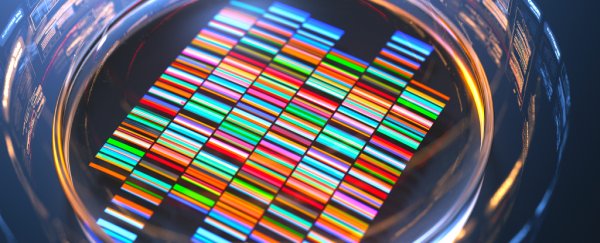Replication is nature's greatest magic trick. Watch closely, and before your very eyes you'll see a single cell blur into two virtually identical copies. Presto.
After more than half a century of research on molecular genetics, it would be easy to assume we've had this biological sleight-of-hand all figured out - but it's not the case.
Now, by applying cutting edge technology, researchers have uncovered crucial details showing how DNA times its own replication.
"It's been quite a mystery," says molecular biologist David Gilbert from Florida State University.
"Replication seemed resilient to everything we tried to do to perturb it. We've described it in detail, shown it changes in different cell types and that it is disrupted in disease.
"But until now, we couldn't find that final piece, the control elements or the DNA sequences that control it."
Open any textbook on the topic and you'll find diagrams showing how long filaments of deoxyribonucleic acid (DNA) act like the world's longest jigsaw-puzzle, constructing nearly identical strands through the employment of clever chemistry and a host of industrious proteins.
Most of us have the luxury of glossing over the details of this enzymatic wizardry in appreciation of the overall trick.
But to researchers, the sheer complexity of the process – especially in organisms like us mammals – has proven challenging to unravel.
Like all good magic tricks, timing is critical. Yet messing with regulatory proteins doesn't seem to make as much of a difference to this as one might expect, indicating the precise rhythm behind replication has more to do with the DNA molecule acting on itself.
To uncover the chemical architecture governing the timing of DNA replication, Gilbert and his team turned to the emerging technology known as CRISPR to snip away at mouse chromosomes in order to work out which factors made a difference.
CRISPR is a molecular toolkit based on a process bacteria use to identify the genes of threatening viruses. Once a specific genetic code is spotted, CRISPR-related enzymes can hone in and break up the sequence, effectively eliminating the threat.
In the hands of researchers, this same system can be used to cut into any designated DNA sequence.
Gilbert used it to target a variety of structures within the DNA architecture of mouse embryonic stem cells, switching them around or cutting them out completely.
Initial focus was on the binding sites for a protein called CCCTC-binding factor (CTCF). This protein helps regulate the whole transcription process, making its landing zone a natural place to look for locations that govern DNA's more spatiotemporal operations.
Yet tinkering with these had little effect on the actual timing of replication processes. Something else had to be at work.
Finding this virtual needle in a haystack would require more than a little luck, though.
It came in the form of a high resolution 3D analysis of the contact sites the DNA was making with itself. In what was a little like a close up of the hands of a skilled magician at work, the team were able to work out which 'fingertips' were in action.
Specifically, they identified several key locations outside of CTFC-associated boundaries. Breaking them caused chaos – replication timing was thrown, the DNA architecture itself was weakened, and transcription was missed.
"Removing these elements shifted the segment's replication time from the very beginning to the very end of the process," says Gilbert.
"This was one of those moments where just one result knocks your socks off."
Their results open the way to new research on health and pathology. By pinpointing the mechanisms responsible for the timing of DNA replication, researchers might uncover processes that give rise to certain diseases.
"If you duplicate at a different place and time, you might assemble a completely different structure," says Gilbert.
We've come a long way since the physicist Erwin Schrödinger delivered his prediction of an 'aperiodic crystal' that could explain the replication of a cell using little more than the physics of basic chemistry.
More than seven decades later, the physics behind molecular genetics is still reluctantly sharing its secrets.
Not that it makes nature's greatest magic show any less amazing.
This research was published in Cell.
